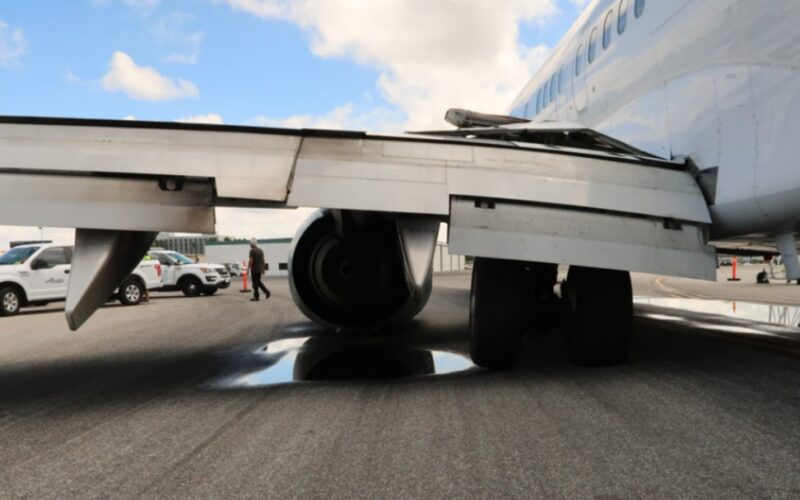The United States (US) National Transportation Safety Board (NTSB) has clarified that an Alaska Airlines Boeing 737-800 did not suffer a hard landing, noting that a fractured pin caused the landing gear to collapse upon landing in California.
The incident happened at John Wayne-Orange County Airport (SNA) in August 2023. The Alaska Airlines Boeing 737-800, registered as N516AS, was operating the regularly scheduled flight AS1288 from Seattle Tacoma International Airport (SEA) to SNA when the left-hand main landing gear (MLG) collapsed upon landing.
According to the NTSB, the flight crew reported that prior to landing at SNA, everything was normal. Weather conditions included “moderate rain, shifting winds, light turbulence, and instrument meteorological conditions until the aircraft broke out at about 800 feet above ground level (AGL)”.
And while the weather improved, both pilots “discussed that a firm touchdown was appropriate”.
Furthermore, the first officer told the NTSB that all systems were operational, including “all of the landing gear position indicator lights were green, indicating both MLG and the nose gear were in their down and locked position”.
Following touchdown, the captain noted that he felt a “firm jolt feeling”, with the aircraft veering “reasonably hard” to the left, with the pilot counteracting that movement with his rudder pedals, keeping it on the runway center line. The captain told investigators that at first he told the first officer he thought the aircraft had a flat tire on the MLG.
Video footage from inside the cabin at the time of the incident were shared on X (formerly Twitter), depicting the aircraft landing and the left-hand MLG spitting out sparks as it rolled down the runway immediately after touchdown.
The crew continued with the post-landing procedures, exiting the runway at taxiway E, when the crew noticed that the Boeing 737 “was listing to the left”. Subsequently, the captain stopped the aircraft on the taxiway, “opened his window, looked outside, and noticed that the aircraft was resting on the left engine cowling”.
Fractured MLG pin
While the left-hand engine was operating normally, the captain proceeded to shut down the engine and the first officer called emergency services.
Notably, the NTSB said the “left landing gear position indicator light was not green anymore; it had gone completely dark, whereas the nose and right MLG position indicator lights were still green”. The first officer proceeded to contact Air Traffic Control (ATC) via common traffic advisory frequency (CTAF), saying that they would stay on taxiway E, with local crash, fire, and rescue teams arriving at the scene.
After emergency services confirmed that no fuel leaks were present and the flight crew affirmed that nobody was injured on board the Boeing 737, passengers evacuated “through the R1 door via stairs onto the taxiway”.
The NTSB noted that an examination of the aircraft following the incident showed that the “MLG aft trunnion pin had fractured”, with the aft end of the left MLG moving upwards, “puncturing the composite panels, and protruded out and above the wing’s surface”.
“The MLG walking beam was also protruding above the surface of the wing. The forward section of the aft trunnion pin was located inside the trunnion and was held in place by a damaged but intact cross bolt,” the NTSB noted, describing the damage to the aircraft.
According to the investigators, the aft section of the pin “had separated and was located in the MLG beam spherical bearing”.
Furthermore, the NTSB affirmed that the landing was normal: the aircraft’s maximum vertical acceleration of 1.71g was below Alaska Airlines’ threshold of 2.2G.
The Boeing 737-800 was carrying 112 people on board, including 106 passengers and six crew members. At the time of publication, the aircraft remains at SNA, according to. flightradar24.com data.
The NTSB said the investigation into the incident will continue, with the board analyzing Cockpit Voice Recorder (CVR) data. In addition, Boeing is analyzing the left MLG trunnion pin at its equipment quality analysis (EQA) laboratory in Seattle, Washington.

